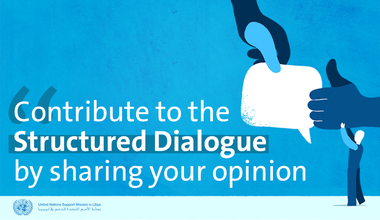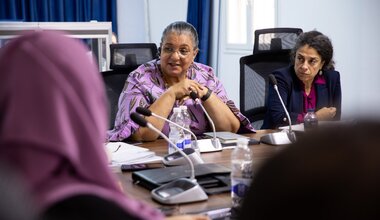Human Rights Report on Civilian Casualties - December 2017
Tunis, 1 January 2018 – From 1 December to 31 December 2017, the United Nations Support Mission in Libya (UNSMIL) documented six civilian casualties - five deaths and one injury – during the conduct of hostilities across Libya, a drop for a second consecutive month. Victims included three men killed and one injured, and two girls killed.
This month also witnessed seven additional casualties from other violations of international humanitarian law and violations or abuses of human rights, including the killing of the civilian Mayor of Misrata, Mohamed Ishtiwi.
The majority of civilian casualties were caused by explosive remnants of war (ERW, four deaths and one injury), followed by gunfire (one death).
UNSMIL documented civilian casualties in Benghazi (three deaths and one injury) , al-Zawiya ( one death) and Sabratha ( one death).
Civilian Casualty Incidents
On 4 December, a 13-year-old girl was killed by a stray bullet while on her family farm in al-Zawiya. At the time of the incident, armed clashes were taking place nearby between unknown armed groups.
On 15 December, a man was killed when an ERW detonated in Sabratha.
Between 8 and 27 December, two men and a six-year-old girl were killed by ERW in the neighborhoods of al-Sabri and Bilad of Benghazi. On 22 December, another man was injured when an ERW detonated in the al-Sabri neighborhood.
Civilian Facilities
On 9 December, an unidentified armed man in civilian dress entered the al-Jalaa hospital in Benghazi and threatened two female nurses. Attacks on medical personnel in al-Jalaa hospital were reported in previous months, prompting the hospital director to urge the head of the Benghazi Security Room to secure the hospital.
On 23 December, four armed men in military uniform raided the al-Arab Medical University in Benghazi, firing shots into the air inside the premises. The incident reportedly took place against the backdrop of an altercation between students and university guards.
Attribution
The Benghazi Revolutionaries Shura Council and allies are believed to have been responsible for leaving mines and ERW in areas of Benghazi they controlled prior to their retreat. UNSMIL was unable to determine with certainty which parties to the conflict had caused the other civilian casualties in December.
Casualties from other violations of international humanitarian law and violations or abuses of human rights
On 4 December, the decomposed body of a policeman was found in a water well in Sabha. He had been missing for several months.
On 10 December, a student at the Faculty of Petroleum Engineering in al-Zawiya University was shot in the leg inside university grounds. The alleged assailant is a relative of a commander of an al-Zawiya-based armed group.
On 11 December, the body of a 33-year-old man from Misrata was uncovered in a water well in al-Khoms, bearing a gunshot wound. His family reported his disappearance on 3 December, and called on the Office of the General Prosecution to investigate the circumstances of his death.
At around 10pm on 17 December, unidentified armed men ambushed the car transporting the Mayor of Misrata, late Mohamed Ishtiwi, and his brother, Ahmed Ishtiwi, in the area of Kharouba. The two were driving home from the Misrata airport. The Mayor was seized and his body was dumped in front of a local hospital, bearing multiple gunshots wounds and a blow to the head, about 30 minutes later. His brother sustained a gunshot wound to the leg.
On 18 December, a 24-year-old man sustained a gunshot wound to the leg in an attempted carjacking incident in central al-Zawiya.
On 23 December, unknown assailants raided the Electricity Company in al-Zawiya and shot dead an employee.
Note
The figures for civilian casualties set out above only include persons killed or injured in the course of hostilities and who were not directly participating in the hostilities. The figures do not include those casualties that are not a direct result of hostilities, for example executions after capture, torture or abductions, or casualties caused as an indirect consequence of hostilities. The figures are based on information UNSMIL has gathered and cross-checked from a broad range of sources in Libya, including human rights defenders, civil society, current and former officials, employees of local governments, community leaders and members, witnesses, others directly affected and media reports. In order to assess the credibility of information obtained, where possible, UNSMIL reviewed documentary information, including medical records, forensic reports and photographic evidence.
The figures are only those that UNSMIL was able to document in the reporting period. They are not likely to be complete and may change as new information emerges about incidents involving civilian casualties that took place during this period.
Similarly, while UNSMIL has systematically tried to ensure that the cases it documented are based on credible information, further verification would be required to attain a higher standard of proof. Due to the security situation, UNSMIL has not been able to carry out direct site visits to all relevant locations in Libya to obtain information. Fear of reprisals against sources further hamper information gathering.
While not all actions leading to civilian casualties breach international humanitarian law, UNSMIL reminds all parties to the conflict that they are under an obligation to target only military objectives. Direct attacks on civilians as well as indiscriminate attacks – which do not distinguish between civilians and fighters – are prohibited. Attacks that are expected to cause incidental loss of civilian life, injury to civilians and damage to civilian objects excessive to the anticipated concrete and direct military advantage are also prohibited. Such attacks amount to war crimes that can be prosecuted by the International Criminal Court.
In order to ensure greater protection of the civilian population and essential infrastructure, all parties engaged in fighting in Libya must cease the use of mortars and other indirect weapons and imprecise aerial bombardments in civilian-populated areas, and not place fighters or other military objectives in populated areas. All executions of captives must cease and all those captured including fighters must be treated humanely in all circumstances. Murdering or torturing captives is also a war crime, regardless of what the captive may be accused of.
Cases highlighted in the “other casualties” section include casualties caused during incidents that would constitute a violation of international humanitarian or human rights law, but are not a direct result of hostilities, for examples executions upon capture of civilians and others hors de combat (such as captured fighters) and torture causing death. The section also includes casualties caused by the proliferation of weapons and impunity enjoyed by armed groups and criminal networks – considered as indirect consequences of hostilities. Cases highlighted in the “other casualties” section are not included in the figures for civilian casualties and include only those that UNSMIL documented during the month.
 United Nations Peacekeeping
United Nations Peacekeeping UN
UN








